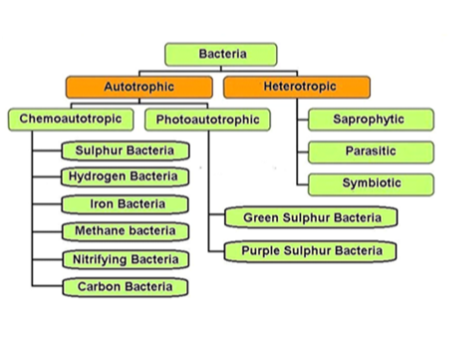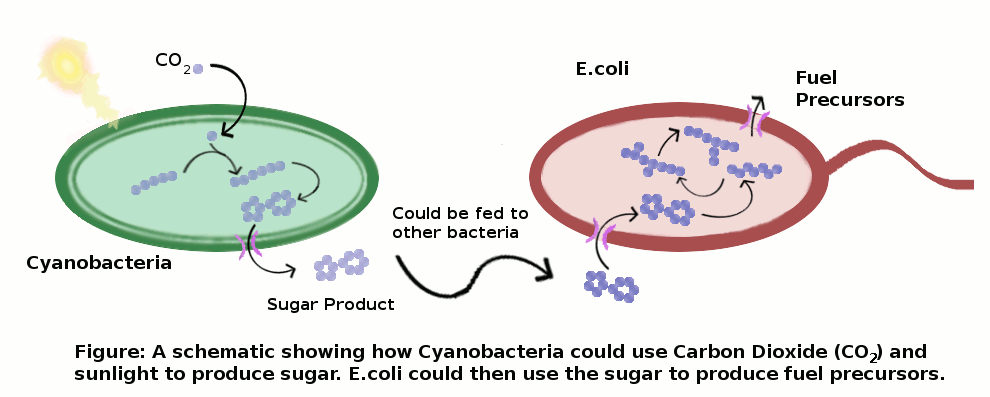Bacteria – Nutrition and Habitat Study Guide
Introduction:
Bacteria live anywhere and almost on all media. This is because they have minimal nutrient requirements – a carbon source, a nitrogen source, and inorganic salts. The other conditions needed for the survival of life are also minimal in the case of bacteria.
Mode of Nutrition in Bacteria:
Bacteria obtain energy from various resources. Many bacteria are capable of making their food and are called autotrophs. Others who depend on other living organisms or organic matter for nutrient needs are called heterotrophs.
Heterotrophic bacteria are classified as saprophytes when they depend on dead and decaying organic matter for nutrition. They live on dead and decomposing animal bodies, excrements of animals, and dead plants. When the bacteria results in harming the living host on which they live for nutritional requirements, they are termed as parasites. Many bacteria live with a give and take policy for their nutritional requirements and are mutualistic.
Autotrophic bacteria depend on light for energy and are called phototrophs. Bacteria source light energy by photosynthesis using organic compounds like electrons and carbon sources. These bacteria are called photoorganotrophs. Photolithoautotrophs are bacteria that depend on light energy sources by photosynthesis using inorganic electron transport molecules and carbon dioxide as carbon source.
How do bacteria get energy?
How do bacteria obtain food? They absorb nutrients from the environment. The nutrients cross the bacterial cell wall and cell membrane through several processes like diffusion, which is mostly passive and facilitated, active transport, or by secreting carrier proteins to the environment to bring the needed nutrients back into the cell.
- Nutrition in bacteria is passed across the bacterial cell through a simple process across a concentration gradient called passive diffusion. This diffusion process is mediated by carrier proteins that make the process-specific, called facilitated diffusion.
- Active transport is an energy-requiring transport of molecules mechanism because the molecules are transported from lower concentration gradient to higher concentration gradient. It also needs carrier proteins to mediate the process.
- When ATP is the driving chemical energy molecule, it is called primary active transport.
- When proton motive force is used for this transport process, it is called secondary active transport. When the energy for active transport is derived from an organic compound other than ATP, it is called group translocation.
- The substances transported are modified to another form or compound during transport.
Conclusion:
- Thus, nutrition in bacteria is a highly adaptable and flexible characteristic feature.
- It is the root cause for the caring habitats that allow them to grow anywhere.
FAQs:
1. What is the habitat of bacteria?
Bacteria are found everywhere on earth – from the soil, rock, oceans, and polar ice. They also live on ever living organisms of all kinds of plants and animals, including humans.
2. How do bacteria nutrition?
Bacteria are the minimal organisms in nutritional requirements, which allows them to survive anywhere. All they need to survive is a carbon source, nitrogen source, and source for inorganic salts. Needless to mention, water is also needed for survival but in insignificant quantities. Bacteria absorb nutrients and do not have any other special adaptation.
3. What nutrients do bacteria need to survive?
Bacteria hardly require any nutrients beyond the minimal supply for survival and life. The nutrients needed by bacteria are carbon, nitrogen, and inorganic salts.
4. What do bacteria need to survive?
Bacteria needs minimal nutrients like nitrogen, carbon, and inorganic salts; most of the bacteria needs oxygen supply for electron transport chain if not an alternate mode of electron transport chain needing nitrates or sulfates; optimum temperature range for a metabolic activity to happen; and other factors like moisture, hydrogen ion concentration, light and osmotic effect for survival.
5. How do bacteria grow on food?
Bacteria can grow on food and other organic matter absorbing organic nutrients, carbon, and nitrogen, besides inorganic salts. This mode of nutrition in bacteria is called heterotrophs, and these bacteria cannot synthesize products to meet their nutritional requirements.
6. How do bacteria survive in nature?
Bacteria survive in nature on a medium like soil, water, plants, animals, deep ocean, hot springs, cold polar ice, glaciers, deeper earth’s crust, and radioactive waste, almost everywhere.
7. What 3 things do bacteria need to grow?
The three things that bacteria need to grow are moisture, temperature, and nutrients. Nutrients will include carbon, nitrogen, and inorganic salt sources. The temperature range and the moisture level where the bacteria can grow the maximum is known as its optimum temperature range and optimum moisture level.
8. Where do bacteria grow?
Bacteria grow everywhere – soil, water, hot springs, radioactive wastes, oil spills, magnetic field, cold polar ice and glaciers, high salt areas, low salt areas, deep earth’s crust, deep ocean beds, plants, and animals.
9. What are the 4 things bacteria need to grow?
The four things that bacteria need to grow are temperature, moisture, pH, and food. The temperature, moisture, and pH with maximum growth are known as its optimum temperature range, optimum moisture level, and optimum pH. The food needed for bacterial growth is minimal as it includes any carbon source, nitrogen source, and inorganic salts.
10. What are the 6 conditions for bacterial growth?
FAT TOM is the acronym used to refer to the 6 conditions needed for bacterial growth. Food, acidity, time, temperature, oxygen, and moisture. The minimal nutrient requirements are carbon, nitrogen, and inorganic salts. As bacteria grow everywhere, they can grow in extreme acidic and alkaline conditions, resilient in survival time at extreme conditions when they are not adapted, withstand extreme heat and cold temperatures, grow in the presence or absence of oxygen. They can live in water and land, including dryness as spores.
We hope you enjoyed studying this lesson and learned something cool about Bacteria – Nutrition and Habitat! Join our Discord community to get any questions you may have answered and to engage with other students just like you! Don’t forget to download our App to experience our fun, VR classrooms – we promise, it makes studying much more fun! 😎
Sources:
- Bacteria Habitathttps://flexbooks.ck12.org/cbook/ck-12-biology-flexbook-2.0/section/7.5/primary/lesson/prokaryote-habitats-bio/ Accessed on 7 Dec 2021
- NUTRITION AND GROWTH OF BACTERIAhttps://nios.ac.in/media/documents/dmlt/Microbiology/Lesson-03.pdf Accessed on 7 Dec 2021
- Microbial Nutritionhttps://bio.libretexts.org/Bookshelves/Microbiology/Book%3A_Microbiology_(Bruslind)/11%3A_Microbial_Nutrition Accessed on 7 Dec 2021
- Bacteria Nutritionhttps://www.ck12.org/biology/bacteria-nutrition/lesson/Bacteria-Nutrition-MS-LS/ Accessed on 7 Dec 2021
- Classification of Bacteria on the basis of Nutritionhttps://microbenotes.com/classification-of-bacteria-on-the-basis-of-nutrition/ Accessed on 7 Dec 2021
- Nutrition in Bacteria – Definition & Typeshttps://www.embibe.com/exams/nutrition-in-bacteria/ Accessed on 7 Dec 2021


